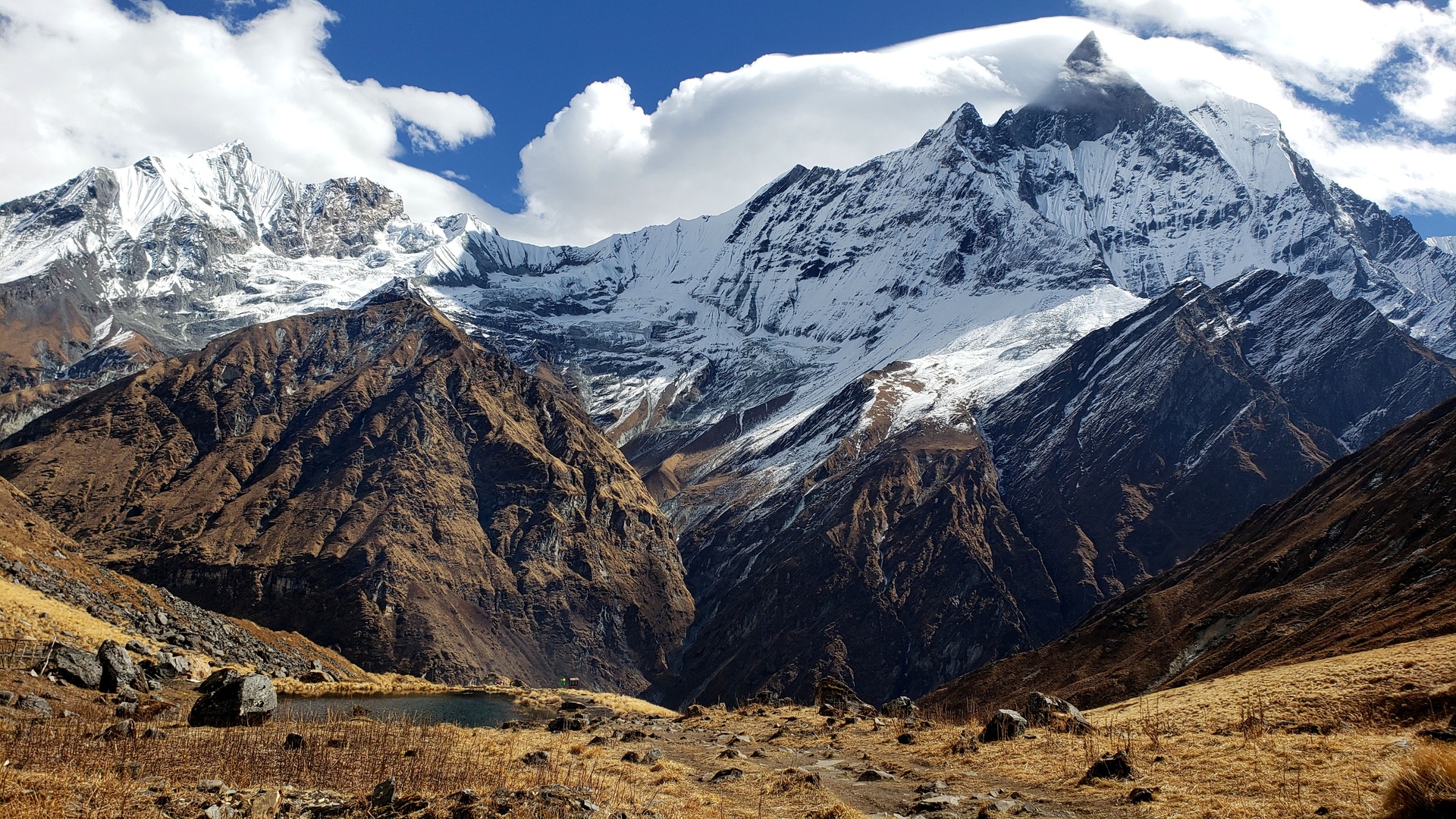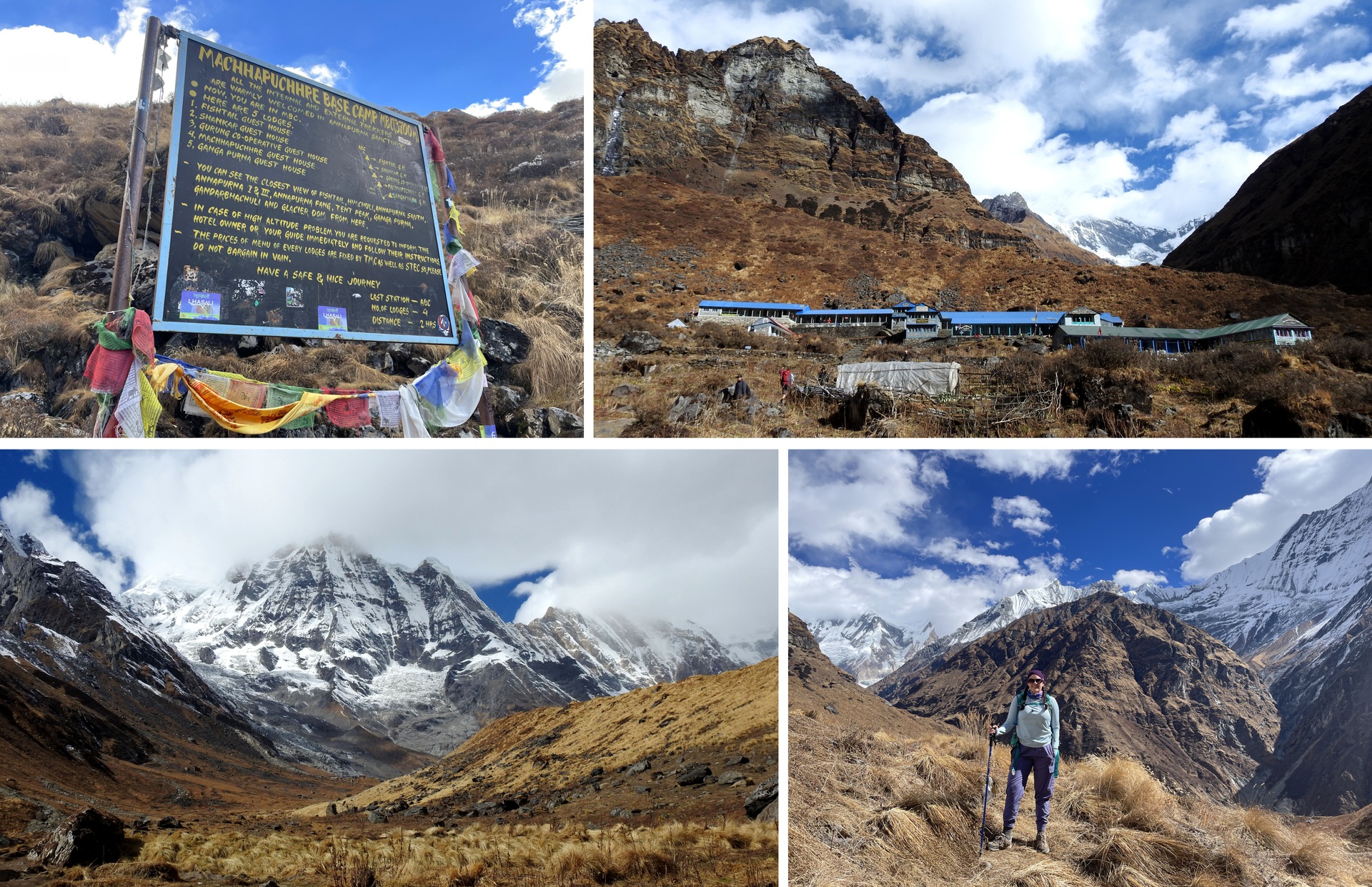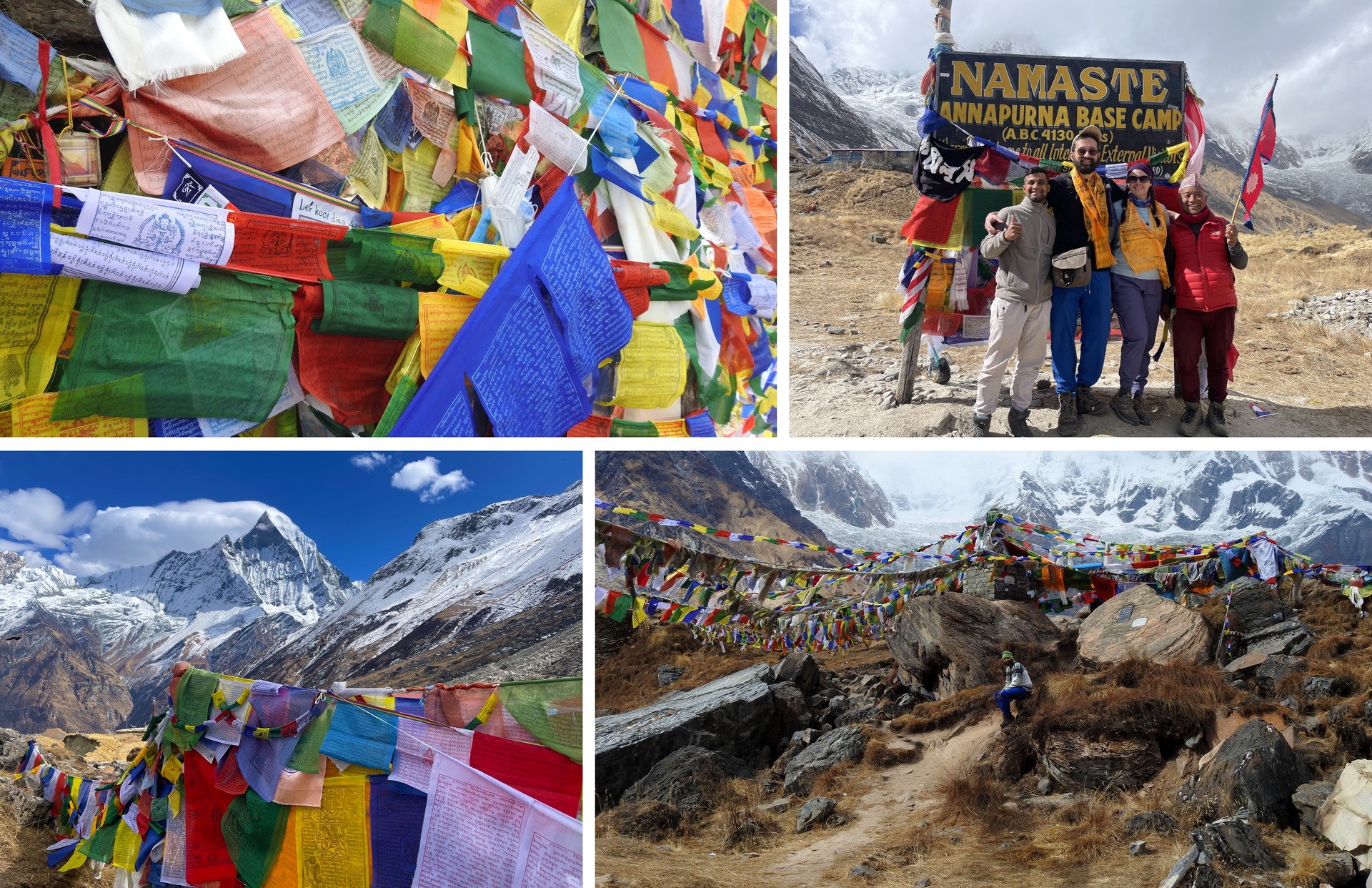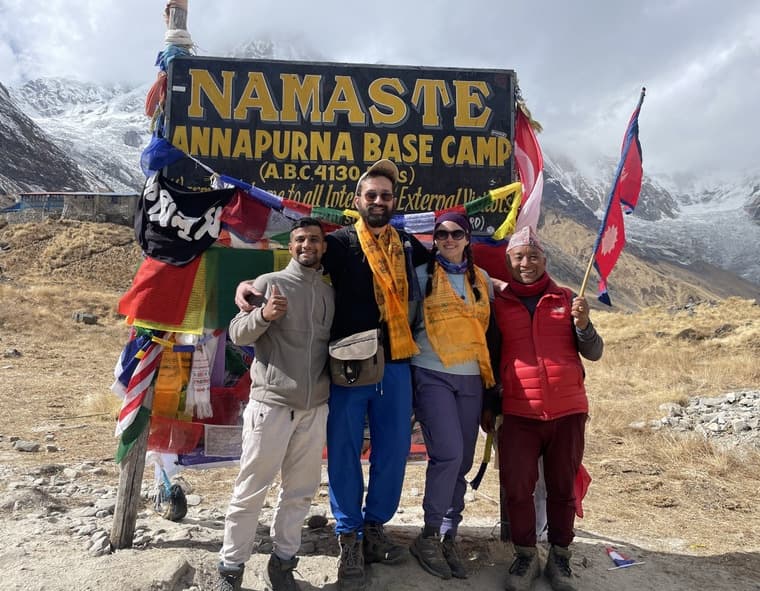“Here is mountain—solid, physical, eminently tactile. And here is metaphor—richly veined, textured, inflected by eons of spiritual folklore. The result of this conjunction between the physical and the metaphysical, between the literal and the emblematic, is Shiva frozen eternally in form. Or to put it another way, here is simply the staggering sight of centuries of abstraction—of incredible mythological and mystical sophistication—embodied in unequivocal stone.”
-Arundhathi Subramaniam

Today’s the big day: after breakfast, we’ll be heading to both Machapuchare Base Camp and Annapurna Base Camp, right within the heart of the mountain amphitheatre known as the Annapurna Sanctuary. While this is only about four miles of hiking, I’ll need plenty of fuel: we’ll be cracking the 4,000-meter mark sometime in the afternoon. And so after reluctantly crawling from my sleeping bag in the early-morning chill of Deurali, I step out of our still-dark room and wash my face in the shared sink that sits in the open-air hallway just outside our door. The mirror is cloudy with water spots, but I’m not too worried about my reflection—the view surrounding Deurali demands all of my attention. The fog of the previous afternoon has lifted like the curtain of a Broadway stage, and the Himalayas have been revealed with hitherto unsuspected majesty and presence. I swap my hairbrush for my camera, keen to capture the remarkable mountain panorama.
To prepare for today’s trek, I sit down to a traditional Nepali breakfast: potato curry and Gurung bread. The latter is a fried flatbread that’s especially tasty with a bit of honey or when dipped in the curry. Although I’m hungry, I set aside a sizeable chunk of the bread, along with a big of egg: I’ve made a new friend just before breakfast, and I can see him waiting through the condensation-fogged window of the guesthouse dining room. If you’ve ever gone trekking in Nepal, you’ve probably encountered the friendly mountain dogs that roam between the teahouses and lodges of the Himalayas. My new buddy is archetypal of that breed: a shaggy black-and-brown dog with matted fur, soft brown eyes, and a slight limp that works itself out as he comes trotting over to me. Sharing the scraps of my breakfast with him, I feel the warmth of companionship that exists only between dog and man. Our friendship will be fleeting, to be sure, but not as fleeting as I first suspected.
For as we shoulder our bags and head out for Machapuchare Base Camp, who comes trotting in our wake but my new friend? For another two hours, we find ourselves hiking alongside the Modi Khola once again. Turquoise water cascades across worn boulders, freezing in patches here and there as we gain altitude: Machapuchare Base Camp sits at about 3,700 meters, and the altitude is now noticeable. I’ve mentioned that our hiking schedule is an accelerated one, and we're taking great pains to stay hydrated as we ascend—nevertheless, we aren’t moving particularly fast. While our canine companion shadows us closely for the first hour or so, he soon grows frustrated with our slow progress and puts on a burst of speed. Before I know it, his bushy tail is lost around a bend in the trail, his shaggy form concealed by the low-lying shrubs that characterize the alpine heights here above the treeline.
Soon the trail narrows, and we find ourselves squeezing past trekkers returning from ABC in the late morning. I relish the opportunity to stop and allow them through the proverbial bottleneck: the Himalayan views here demand my attention. Hari points out a saddle sloping away from the summit of Machapuchare. Not unlike Kanchenjunga in the eastern Himalayas, the saddle is known as a “sleeping Buddha:” with a little imagination, we can see a head, rounded belly, and reclined feet. Privately, I think that it more closely resembles a tremendous stone face of dizzying proportions: nose, upper lip, and lower lip. I can almost imagine it turning to face us with a great upheaval of rock, triggering one of the very avalanches which are so dangerous on this particular stretch of the trail. I imagine those terrible eyes alighting on us with a great grinding of stone upon stone. Would they approve of what they saw? In the face of judgment from the eternal, would I pass muster? Such are one’s thoughts at 3,700 meters in elevation.

Fortunately, we’re trekking in the winter: well outside of avalanche season. The sleeping giant, whatever his nature, lets us pass without incident. But evidence of the mountains’ wrath is plain to see if you know what you’re looking for, and Hari certainly does. He directs our attention to a massive slab of glacial ice lying in the bushes on our left. From the trail, it looks much like a colossal chunk of rock: just another piece of the mountains. But when we venture off the path to lay our palms on its frozen surface, its true nature becomes clear. This is a piece of ice beyond anything I could have imagined, and it brings home the true scope and scale of an avalanche in the Himalayas. There would be no outrunning, no escaping a calamity of this size. It’s no wonder that the locals closely monitor this section of the trail, ensuring the safety of hikers enjoying the Annapurna Base Camp Trek. As we return to the trail, I’m certainly grateful for their vigilance.
Before long, we find ourselves climbing into Machapuchare Base Camp, or MBC. This is a “base camp” in name only: Machapuchare has never been summitted, as it's considered a sacred peak, and there’s no sign of any climbers as we arrive. But it is a very fine collection of guesthouses and restaurants, and we stop for a mug of black tea and sit companionably in the sun, enjoying the fabulous view of Annapurna South that’s now visible from this part of the trail. As I take in the splendid Himalayan panorama, I see that MBC holds another surprise or us: our canine friend from this morning! Recognizing us, he trots over to accept a biscuit that I’ve been saving for just such an occasion. I find myself wondering how big this dog’s territory must be: how many times does he trek between ABC, MBC, and Deurali in any given week?
With the sun on our faces and warm mugs of tea in our gloved hands, we spend a good 20 or 30 minutes here at base camp, enjoying unparalleled views of Hiunchuli, Machapuchare, and Annapurna South. This is the Annapurna Sanctuary—this is what we’ve come so far to see. I take a few time-lapse movies on my camera: not a particularly inventive trick, maybe, but one which always produces a lovely effect as clouds cascade in streams across the face of the mountains. Plenty of trekkers spend the night here at MBC and make for ABC just in time for a spectacular golden sunrise. We’ve chosen to push on this afternoon, and although Annapurna South seems close enough to touch, there’s still plenty of ground to cover.
With Machapuchare Base Camp now behind us, I find myself turning around now and then to appreciate the closeness and size of the mountain known locally as Fishtail. Clouds eddy and swirl across the mountain’s frosted summit like so much whipped cream: clear now, obscured just a moment later. The mountain presents an entirely different face each time I turn to look, and I begin to feel that my head's on a swivel. With Annapurna South in front of me and the Fishtail behind, I'm certainly spoiled for views. But where I really need to be looking is the ground. This is something of a sad truth of trekking: between precarious stairs and uneven, rocky ground, you’re bound to spend a lot of time looking at your own feet. At least I know that the mountains will be there when I stop to take a rest—when you’re within the Annapurna Sanctuary itself, it would take some mighty fog to obscure them from view.

The final ascent to Annapurna Base Camp takes us about two hours, and it's a gentle climb. Before long, the distinctive blue guesthouse roofs come into view—but it’s still some time before we arrive. Distances in the Himalaya can be deceptive, and the closeness of the mountains is belied by the tiny figures of our fellow trekkers on the path ahead. We continue past a stream frozen in suspended animation, where only trickles of clear water break free from the morass of ice. And then, almost before we know it, we've made it! Namaste Annapurna Base Camp, the sign proclaims. To our surprise and delight, Hari produces khata scarves for both of us to wrap around our necks. The bright yellow fabric is adorned with the eight auspicious symbols of Tibetan Buddhism known collectively as the ashtamangala: the endless knot, lotus, victory banner, Dharma wheel, treasure base, golden fish, parasol, and conch shell.
We take a series of photos here to celebrate our accomplishments before getting checked in at one of the ABC guesthouses. We’re fortunate enough to secure a private room, which is something of an accomplishment in its own right here at busy Annapurna Base Camp. After stowing our bags, we decide to check out a nearby monument draped with hundreds of prayer flags. The monument’s centerpiece is a bust of Maurice Herzog, a French mountaineer who reached the summit of Annapurna I in 1950. It's one of the most beautiful spots I've ever seen in the Himalayas, and standing here is nothing short of a privilege. We’re treated to clear blue skies, white mountains, and good company—what more could a trekker want?
After exploring the immediate surroundings of base camp, we sit down to lunch. It’s hard to believe it’s only midday, but my appetite belies the earliness of the hour: I manage a generous helping of momos and a plate of fried rice. Krista, on the other hand, seems to be developing a taste for Nepali mountain pizza. We make quick work of lunch and decide to go exploring with Hari. Not content with a mere 4,100 meters, we clamber onto the hills behind Annapurna Base Camp. As we climb one grassy knoll after another, Hari explains that no one has ever made a successful attempt on the mountain from this base camp. It’s an exceptionally dangerous climb, and the way leads across capricious glacial moraines where avalanches are a frequent and deadly occurrence. Even standing here, I can hear the distant echo and clatter of rocks as they tumble down sheer cliffs and escarpments cloaked in fog and shadow.We climb higher still, gaining another 100 meters as we get a better look at the glacial moraine. I reflect upon the fact that this might be the hardest 100 meters of the entire trek, thanks for the considerable altitude we’ve now achieved. There’s a sad fact to consider: in Hari's 38-year trekking career, the glacial moraine of Annapurna has declined dramatically. The mass of ice, soil, and rock once reached all the way to Annapurna Base Camp; now it stands at a comparative distance, resting at the foot of Annapurna I. How much longer until it vanishes entirely? This is not a uniquely Nepali problem, as the impacts of climate change are felt across the entire world. But it's easier to see here, and I wish more people could see it with their own eyes.

On the way back down to ABC, we encounter our old friend: the dog from Deurali. I’m no longer surprised to see him, but I’m certainly pleased. I offer the crumbled remains of a last biscuit from my pocket, and we troop back to base camp in a line. Sunset is not far off, and it's a sight to behold: the fishtail summit of Machapuchare flushes a roseate gold before blazing brilliantly in the last light of the dying sun. Until now, Annapurna I has been cloaked in mist and swirling eddies of cloud. But as the light fades from the sky, the face of the world’s 10th-highest mountain finally reveals itself. Later, after dinner, we even have the privilege of glimpsing Annapurna I at full dark, shining with reflected starlight and snow. It’s a fine sight, despite the freezing temperatures, and I think to myself that our efforts on the trek to Annapurna Base Camp have been rewarded in spades.



